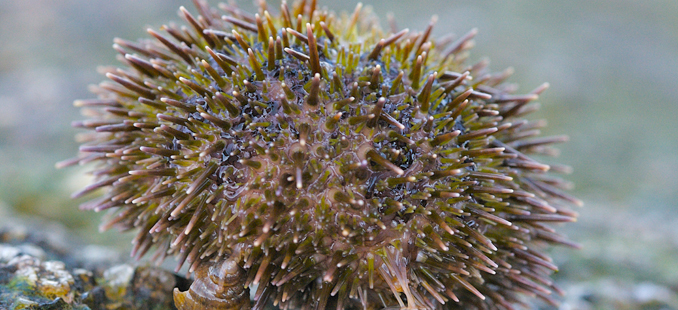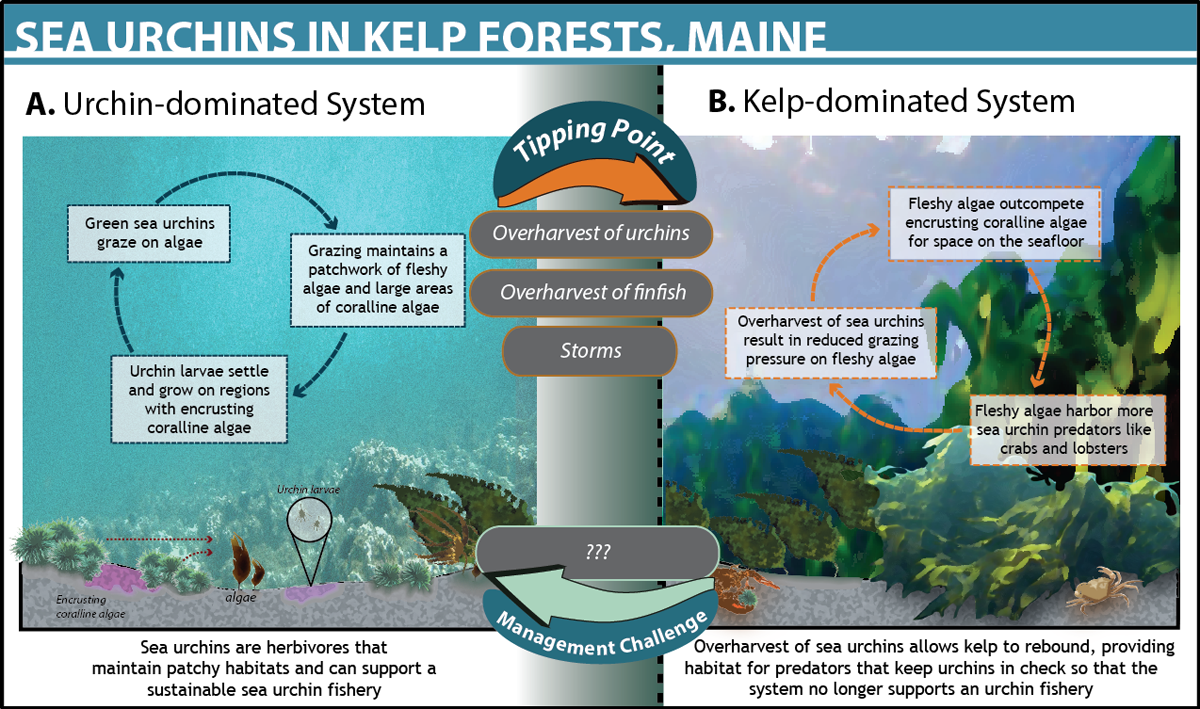Following cod collapse, urchin populations boomed, but they in turn were overharvested, resulting in kelp forest ecosystem shifts and fishery collapse
Tipping points for green sea urchins in Maine
Kelp forests are underwater communities dominated by large macroalgae (seaweeds) that create dense “forests” that provide habitat, food, and shelter for a diverse array of fish and invertebrates. They also provide important habitat for species such as sea urchins, crabs and fish, which are economically valuable to fishermen and coastal communities in Maine. Historically, large predatory fish such as cod dominated coastal regions in Maine; yet widespread overfishing over the centuries decimated cod populations, resulting in a boom in other species, particularly sea urchins. Green sea urchins graze macroalgae and maintain open patches of encrusting coralline algae interspersed among the kelp. Those open patches of coralline algae facilitate settlement of urchin larvae, who shelter under the spines of bigger adults, away from their predators, like crabs and lobsters, which are more abundant under the kelp canopy.1
Beginning in the late 1980s, fisherman in Maine discovered the high value of harvesting sea urchins from Maine’s kelp forests, whose “roe” or reproductive organs are a delicacy in Asian communities.2 The aggressive overharvesting of the green sea urchin resulted in massive declines of urchins along the coast: stock assessments indicated a 90% decline in sea urchin biomass across the state between 1986 and 2001.3 The continued depletion of green sea urchins initiated further large-scale shifts in the Gulf of Maine ecosystem, where macroalgae became highly abundant. The overharvesting of urchins resulted in a tipping point for the system, shifting from an urchin-dominated patchy kelp forest, to one devoid of sea urchins and teeming with crabs and lobsters that now thrive in the dense and established kelp forests.1
The Management Response
The steady decline of lucrative sea urchin landings since 1993 initiated concern among both fishermen and managers. In response, and at the request of sea urchin industry leaders, the Maine legislation created the Sea Urchin Research Fund (SURF) in 1995 to study the continued decline of the fishery.4 The research produced proved valuable for understanding the dynamic ecological relationships among the interacting species in Maine’s kelp forest ecosystems.
Monitoring of green sea urchins, crabs, and algal cover was conducted between 1996 and 2002. Regular monitoring indicated that thousands of sea urchin larvae settled in the kelp forest, yet nearly none survived to adulthood. Scientists attempted to restore urchin populations through translocation of urchins from other regions into Maine’s kelp forests. These experiments found that crabs have become the new apex predator in the densely established kelp forests, consuming sea urchins and their larvae before they can reach stable population numbers.1
Although Maine has established a variety of regulations since 1992, they have not successfully halted or reversed the decline of green sea urchin populations.5 Following the sea urchin decline, a crab fishery soon became a new target for fishermen. However, even the removal of crab predators by this fishery has not reduced crab populations enough to restore urchins.6 Additional steps by the Department of Marine Resources advisory board include splitting the fishery into two management zones, setting limits to the number of sea urchin harvesters, and applying minimum and maximum size limits on harvest urchins.4 Managers have also been working with scientists to use monitoring data collected over the past few decades to create mathematical models of the ecological system and offer insight into more effective future management plans.
What We Can Learn
The sudden rise in the demand and value of urchin roe in the late 1980s commenced widespread overharvesting and mismanagement of the green sea urchin fishery in Maine. Unfortunately, by the time fisherman and managers observed the decline in urchin populations, it was too late as population levels had already crossed an ecological “tipping point.” Now, the ecosystem remains in a kelp-dominated state and the once dynamic system that supported patchy habitats by grazing green sea urchins is no longer sustainable.
The loss of green sea urchins in Maine impacted many people’s livelihoods and continues to hinder future economic prospects for the fishery. The story of the Maine sea urchin fishery emphasizes the need for ecosystem-based management and increased recognition about interactions between species. The immense overharvesting of green sea urchins indirectly initiated a cascading effect that reinforced and locked the system into an alternative ecosystem with fundamentally different ecosystem services. Furthermore, the Gulf of Maine’s coastal ecosystem evolved under strong top-down control by predatory finfish, and the rise in crabs as apex predators was only possible because of earlier fisheries–induced declines in their finfish predators.1 While the rise in crabs and lobsters have become new targets for fisheries in Maine, this information taken together still signifies the need to incorporate multi-species and ecosystem-based management into management plans if any fisheries are going to be successful in the long-term future.
As the Ocean Tipping Points team has come to understand, the most successful scenarios for resource management occur when management is threshold-based, populations are monitored routinely, and the geographic scale for management is relatively small.
Learn more about our Management Review research and Ocean Tipping Points project.






